Introduction:
Art has the remarkable ability to transport us to different worlds, evoke emotions, and ignite our imaginations. While we often appreciate art through our sense of sight, there is another dimension to explore: the tactile beauty of artful textures. In this article, we delve into the captivating world of texture in art, where the brushstrokes, sculpted forms, and mixed media creations invite us to engage not only visually but also through touch.
- Engaging the Senses: The Multisensory Experience of Art
Art is not confined to the visual realm alone. Artists have long recognized the power of incorporating textures to enhance the sensory experience of their work. By introducing tactility, art becomes more immersive, inviting viewers to connect with the artist’s vision on a deeper level.
- From Smooth to Rough: Unveiling the Diversity of Textures
The world of artful textures is incredibly diverse, ranging from the smooth surfaces of classical sculptures to the rough and expressive brushwork of abstract paintings. Every artist employs various techniques and materials to create surfaces that convey their intended message and elicit specific sensations.
a) Sculptures: Capturing the Essence of Touch
Sculptures embody a three-dimensional texture, allowing us to explore the interplay between light and shadow as our hands trace the contours. Whether it’s the cool marble of Michelangelo’s “David” or the intricate details in Auguste Rodin’s bronze masterpieces, sculptures evoke a tactile experience that brings us closer to the artist’s creation.
b) Paintings: Brushstrokes That Speak Volumes
Paintings have a unique language of their own, and textures play a vital role in conveying the artist’s emotions and intentions. Whether it’s Vincent van Gogh’s thick, swirling brushstrokes in “Starry Night” or the delicate layers of impasto in a contemporary abstract piece, textures in paintings evoke a range of sensations, from tranquility to raw intensity.
c) Mixed Media: Exploring Boundaries and Possibilities
In the realm of mixed media art, artists push the boundaries of textures by incorporating unconventional materials. From collages of textured fabrics and papers to the intriguing combination of metal and wood, mixed media art creates a tactile symphony that mesmerizes both the eyes and the hands.
- The Haptic Renaissance: The Rise of Tactile Art Appreciation
In a world that has become increasingly digital, the haptic renaissance is gaining momentum, drawing attention to the importance of physical touch and sensory experiences. Exhibitions and art installations focused on tactile art are emerging, encouraging viewers to actively engage with the artwork using their fingertips. These immersive experiences challenge traditional notions of art appreciation and forge a deeper connection between the audience and the artist’s creations.
- The Ethical Considerations of Tactile Art
While engaging with art through touch offers a profound experience, it also raises important ethical considerations. The preservation and protection of artwork become paramount, necessitating a delicate balance between allowing viewers to interact and ensuring the longevity of the artwork. Museums and galleries are continuously exploring innovative ways to strike this balance, using protective barriers, interactive installations, and guided experiences.
Conclusion:
From ancient sculptures to contemporary mixed media creations, the world of artful textures invites us to explore and appreciate art beyond its visual form. By incorporating tactile elements, artists enrich our experience, allowing us to immerse ourselves in their creative visions. As we continue to embrace the multisensory nature of art, let us revel in the beauty of textures, recognizing their ability to awaken our senses




